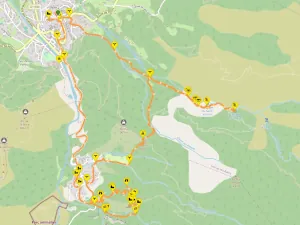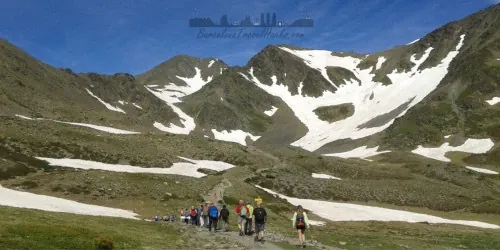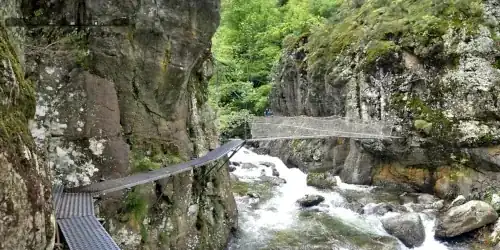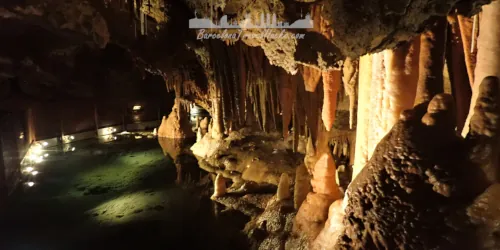
French Pyrenees Weekend - Abbaye Saint-Martin-du-Canigou
13km circular hike from Vernet-les-Bains via forest waterfalls to the 11th Century Saint-Martin du Canigou Abbey and viewpoints in the Canigou mountains
About Saint-Martin-du-Canigou Abbey Hike
The 11th century Romanesque Abbey of Saint-Martin du Canigou is situated at the heart of the Canigou mountain range at an altitude of 1094 metres on a rocky ridge overlooking the Cady river Valley. The abbey was listed as a historical monument in 1889, because it is a beautiful example of Norman architecture.
This 13 kilometre medium circular hike starts in Vernet-les-Bains town centre and follows a country lane to the village of Casteil where a pedestrian paved trail leads up the the Abbey via Saint Benoit chapel. The return route is via a tranquil forested river valley path with waterfalls, red squirrels, bird species such as Nuthatches and Black Redstart and a variety of butterfly species.
Saint-Martin du Canigou Abbey History
Founded in 1009 AD by Guifred II, Count of Conflent and Cerdanya and was populated by Benedictine monks for eight centuries during which some notable events occurred.
In 1050, Guifred II died at the monastery after having served as monk for 15 years after construction the monastery.
The monastery was damaged in the Catalan earthquake of 1428, known as terratrèmol de la candelera in Catalan, because it took place during candlemas. The epicentre was recorded near Camprodon on the edge of the Parc Natural de la Zona Volcànica de la Garrotxa. The earthquake was one of a series of related seismic events that shook Northern Catalonia in a single year. Beginning on 23 February 1427, tremors were felt in March, April, 15 May at Olot, June, and December. Note that these seismic events are not thought to be related to the now dormant volcanic area of Catalonia because geologic evidence places the formation of the Santa Margarida crater to 11,500 years ago.
The monastery was secularised in 1782 by king Louis XVI and abandoned by the monks in 1783-1785, falling into disrepair. During the French revolution in a period known as the 1793 to 1794 Reign of Terror, the abbey was closed, and its contents including the capitals of the cloister, sculptures and furniture were looted.
From 1902 to 1932, the bishop of Elne and Perpignan, Jules-Louis-Marie de Carsalade du Pont, restored the ruins. Father de Chabannes continued the renovations in 1952. And, as of 1988, the Catholic Community of the Beatitudes resides in the abbey and whose mission is prayer and to welcome both tourists and those in search of spirituality. The marble capitals of the cloister were looted but in the reign of terror but recovered during the restoration as part of a diligent search for original dispersed material of the abbey.
The abbey consists of two churches in the First Romanesque style. Josep Puig i Cadafalch (Early 20th century architect and former president of Catalonia) coined the term First Romanesque to describe a style of architecture that developed in the north of Italy, parts of France, and the Iberian Peninsula during the 10th and 11th centuries. First Romanesque, also known as Lombard Romanesque, is characterised by:
- Thick stone walls
- Lack of sculpture
- Lombard Bands, a decorative blind arcade of ornamental arches, usually exterior
First Romanesque architectural style is attributed to groups of Lombard teachers and stonemasons working in the Catalan territory during the first quarter of the 11th century. Abbot Oliba of the Santa Maria de Ripoll Monastery was an influential sponsor of the First Romanesque style.
The lower church is dedicated to Saint Mary vault heights up to three metres with the apses and adjacent bays believed to be original from 1009 AD with the rest of the building dating from 1010 to 1020 AD. The upper church is dedicated to Saint Martin and built between 1010 and 1020 AD and required the strengthening of the columns of the lower church. The gate house is no taller than 19 metres after being damaged in the 1428 earthquake. The rest of the convent buildings date from the early 20th century.
The Abbey of Saint-Martin du Canigou is on the pilgrimage Routes of Santiago de Compostela also known as the Camiño de Santiago de Compostela. This is a world famous network of hiking pilgrims paths leading to the shrine of the apostle James in the cathedral of Santiago de Compostela in Galicia in north-western Spain. Saint-Martin du Canigou abbey is on the Camino de Santiago French route that traverses from eastern France crossing the Spanish border at Roncesvalles.
Saint-Martin du Canigou Abbey Hiking Route
The route starts at Vernet-les-Bains where we park near the Sant Sadurní de Vernet church and take a walk around the town before taking the Chem. la Forêt et du Saint-Vincent rural road which transitions into a path leading into a forested area towards the Cascade du Saint Vincent waterfall.
After about 2.5 kilometres, the route takes a path forking off to the right. However it is worth walking an additional 1.5 kilometres further up this path to visit the two waterfalls of Cascade du Saint Vincent and Cascade des anglais. This section of path crosses several wooden bridges over Ribera de Sant Vicenç mountain river. Back track along the same path and take the fork to the village of Casteil.
At Casteil after passing Camping Domaine St Martin take a left turn onto a road that passes the village cemetery and continues down to the Auberge del Cadì hostel and Sant Martí de Castell. Take the ascending road Chem. de l'Abbaye which is signposted to Saint-Martin du Canigou Abbey. This pedestrianised road is a 1.5 kilometre ascent along a winding mountain road passing by Chapelle saint Benoit. Behind this chapel is a picnic bench and viewpoint looking down to Casteil and Vernet-les-Bains.
The first thing you see when arriving at the Saint-Martin du Canigou Abbey is the Lombard tower. as you get close the road offers a great view of the lawns and garden in front of the abbey. Just before arriving at the abbey, there are some steps on the right. this leads up to another picnic area and after walking 250 metres, a viewpoint looking down on Casteil and Vernet-les-Bains. Backtracking to the Abbey, the best place to view it from is above following a path that starts at some steps at the corner of the abbey. After about 100 metres there is a short path on the left to the most spectacular viewpoint of this route. Note that it is also possible to visit the interior of the abbey.
Returning to the abbey, the descending route is via steps behind the abbey that go down into the forest below and the river Cadi valley. As you follow this section of the route the path crosses the river several times under the tree canopy. When you get to a wooden bridge crossing the river and keep an eye out for a right fork in the path. It is worth walking about 100m up this fork to see another waterfall before backtracking and continuing down to the Route de Mariailles road.
Follow Route de Mariailles back to Casteil village passing Les Saveurs du Cady restaurant. I recommend stopping off here for a beer and snacks or lunch. If this restaurant is closed then a further 100m along this road is La Mirabelle-Casteil Country House and Restaurant and Au Fil Du Temps restaurant.
Follow the D116 country lane for 2km back to Vernet-les-Bains. just before getting to the town on the right is Thermes de Vernet-les-bains thermal baths. Returning to the parking area via Boulevard Lambert Violet passing the Monument à l'Entente Cordiale. it is worth walking up the stone steps to take a look at this monument.
Image Gallery For Saint-Martin-du-Canigou Abbey Hike
Click on any of the 38 images to open full screen gallery player. Note that viewing images is subject to our Fair Use Policy.
Visiting Saint-Martin-du-Canigou Abbey Hike
- If you want to visit the abbey but are not interested in doing the hike then there are 4x4 tours departing from Vernet-les-Bains.
- JPB Bouzan: +33(0)6 50 33 95 79
- Transport Villacèque: +33(0)4 68 05 51
Hiking to Saint-Martin du Canigou Abbey with a dog
This route is great with a dog and does not present any difficulties. Note that some of the route does involve walking along a rural road so you may have to use the leash. Your dog can swim a in the streams.
Around the abbey, foliage is dense forest of mostly oaks, beeches and cork with the occasional pines. The chances of finding poisonous Pine Processionary Caterpillars is low but diligence is advised in spring and summer.
Saint-Martin du Canigou Abbey Spiritual Retreat
- The Catholic Community of the Beatitudes at Saint-Martin du Canigou Abbey welcomes people wishing to stay at the abbey for two to six days (excluding Mondays) for:
- Those who are seeking a place of spiritual renewal, silence and peace
- Those who are at a turning point in their lives and feel the need to take some time out to reflect and to pray
- Young people (and not so young people!) who are seeking direction in their lives
- The baptised who desire to share in the fraternal and liturgical life of a community for a few days
Visit the website to read more about the spiritual retreat.
Saint-Martin du Canigou Abbey Guided Tours
- Equally, the Catholic Community of the Beatitudes also welcome tourists that want a guided tour of the Abbey at the below times:
- Monday: Closed
- Tuesday to Saturday: 10:00h, 12:30h, 14:00h, 15:00h & 16:00h
- Sunday: 10:00h, 11:00h, 14:00h, 15:00h & 16:00h
- Monday: Closed
- Tuesday to Saturday: 10:00h, 11:00h, 12:00h, 14:00h, 15:00h, 16:00h & 17:00h
- Sunday: 10:00h, 12:30h, 14:00h, 15:00h, 16:00h & 17:00h
- 1st February to 31st May & 1st October to 31st December:
- 1st June to 30th September:
Saint-Martin du Canigou Abbey Guided Tour Tickets
- Standard: €8.00
- children 12-18 yrs, students, unemployed, large families, handicapped: €6.00
- Pre-booked group tour for 20+ persons: €7.00
- under 12 years: FREE
See the website for more group discounts such as school trips.
What to take with you for Saint-Martin-du-Canigou Abbey Hike
I take a small 30L hiking rucksack and carry three litres of water to do this route wearing comfortable and sturdy hiking boots or shoes.
Saint-Martin-du-Canigou Abbey Hike Summary of Prices
Getting to Saint-Martin-du-Canigou Abbey Hike
Address: Vernet-les-Bains, Casteil, France, 66820
Leave Barcelona via the C58 motorway passing Sabadell and Terrasa and transition onto the C16 passing Berga. Take the toll Tunnel de Cadí (€13.93 for a car) and after passing the toll booths at the northern end there is a service station Àrea de Servei Túnel del Cadí - Porta Cerdanya. immediately after the service station is junction onto the C162 towards Puigcerdà.
At Puigcerdà cross the border into France taking the N116 to Mont-Louis. At Mont-Louis roundabout, Continue along the N116 towards Villefranche-de-Conflent where you can take a right turn onto the D116 to Vernet-les-Bains. I recommend parking near to Monument à l'Entente Cordiale.
Wikiloc Trail for Saint-Martin-du-Canigou Abbey Hike

Please sign in with Google to view the Wikiloc Route map.
Sign in with GoogleWeather for Saint-Martin-du-Canigou Abbey Hike
Mountain Forecast weather for Canigó summit near Castell
Where to stay overnight near Saint-Martin-du-Canigou Abbey Hike
Nearby Attractions to Saint-Martin-du-Canigou Abbey Hike
 CAR
CAR
French Pyrenees Weekend - Pic de Carlit Mountain Hike
15km Medium-Hard vertigo inducing circular mountain hiking route via lakes of the lac de Bouillouse French Pyrenees region to the 2921m Pic de Carlit summit
Read more >
 CAR
CAR
French Pyrenees Weekend - Gorges de Carançà
12km circular scenic hike along Carançà river valley via suspension bridges and canyon side walkways along a forested Pyrenees mountain river
Read more >
 CAR
CAR